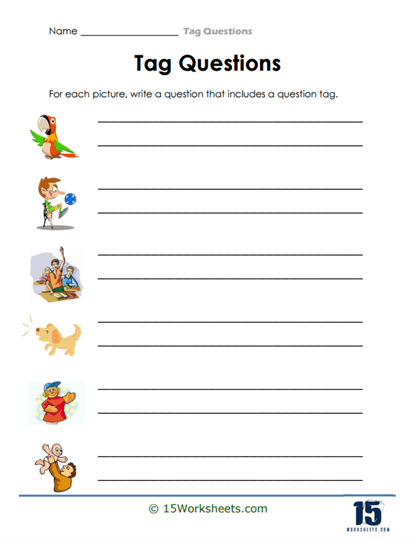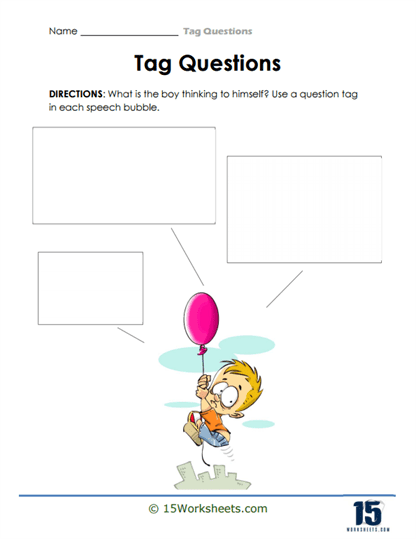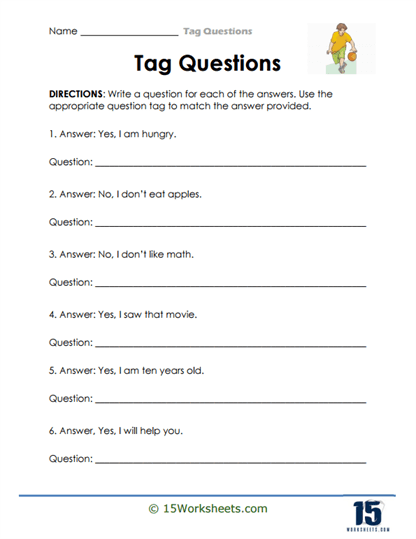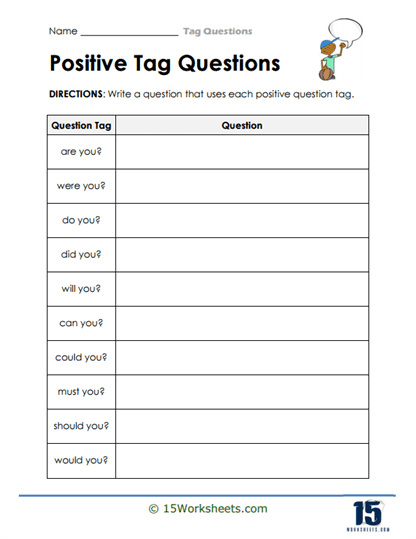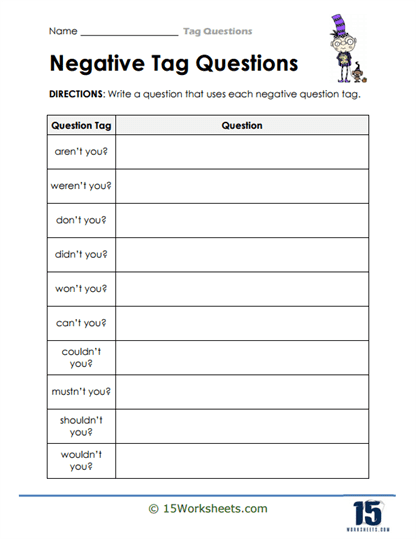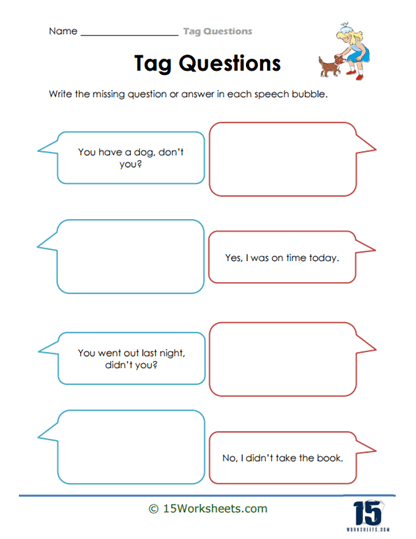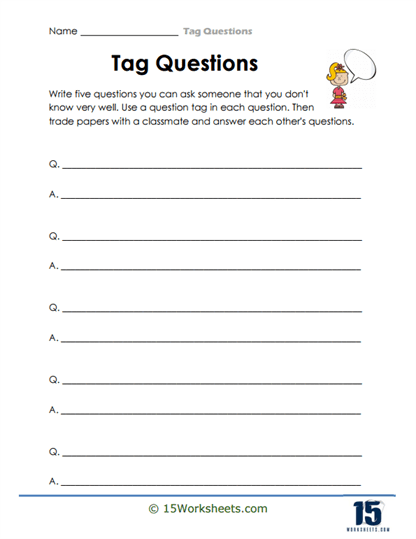Tag Questions Worksheets
About These 15 Worksheets
The collection of these worksheets will help students, teachers, and homeschoolers master the use of tag questions in English. Tag questions are a crucial aspect of everyday communication, enabling speakers to seek confirmation, express opinions, or keep a conversation going. This collection offers a variety of exercises that cater to different learning styles, providing students with a comprehensive understanding of how tag questions work in different contexts. The worksheets are available in PDF format, making them easy to view, download, and print, which ensures that they can be seamlessly integrated into any lesson plan or home study session.
One of the fundamental worksheets in this collection involves completing sentences with the appropriate tag question. For example, students are given sentences like “You like peas,” and they must add the correct tag, such as “don’t you?” This exercise helps students practice forming tag questions based on the verb tense and subject of the sentence. By repeatedly engaging with these prompts, students become more confident in their ability to use tag questions correctly in various situations. The straightforward format of these exercises makes them ideal for both classroom use and individual practice.
Another engaging worksheet encourages students to ask a question in response to a given statement using a tag question. For example, students might be presented with the statement, “I’m tired,” and they need to respond with, “Aren’t you?” This activity teaches students how to use tag questions to keep conversations going, a key skill in natural spoken English. It also allows students to practice the intonation and emphasis that is often used when asking tag questions, which can differ slightly from regular questions. This worksheet is particularly useful in helping students develop conversational fluency, making them more comfortable in real-life interactions.
The collection also includes a worksheet where students add the correct question tag to sentences as they interview their classmates. This interactive activity not only reinforces the correct formation of tag questions but also encourages students to engage with one another, making the learning process more dynamic and social. For example, students might ask their classmates, “You have a dog, don’t you?” and then record their answer. This activity fosters communication skills, making it perfect for group settings or language workshops where students can practice speaking in a more natural and engaging way.
Another worksheet in the collection challenges students to choose the correct tag question to complete each sentence from multiple-choice options. For instance, students might be given the sentence “You weren’t late, ____?” and must choose between “are you” or “were you.” This exercise sharpens students’ understanding of how different verb tenses and forms influence the correct tag question. The multiple-choice format is beneficial for testing students’ knowledge and for quick assessments in the classroom. It also helps students understand the subtleties of tag questions, such as when to use positive or negative forms.
In addition to these foundational exercises, the collection includes more advanced activities like sentence unscrambling, where students must correctly reorder words in a jumbled sentence that includes a tag question. For example, they might encounter the jumbled sentence “you do chores you’ll your won’t,” which they need to rearrange to form “You’ll do your chores, won’t you?” This type of exercise challenges students to apply their understanding of sentence structure and tag questions in a more complex way. It also reinforces the importance of correct punctuation and word order in forming coherent sentences, a crucial skill in both written and spoken English.
Another creative worksheet asks students to fill in speech bubbles with tag questions that a character might be thinking. This activity allows students to explore how tag questions are used in informal thoughts or dialogue, which is a common context for these types of questions. For example, students might see a picture of a boy with a balloon and write, “I hope this balloon doesn’t pop, does it?” This exercise encourages students to think imaginatively and apply their knowledge of tag questions in a fun and relatable way. It’s particularly useful for younger students or those who benefit from visual learning aids.
The collection also features a worksheet focused on negative tag questions, where students are given a list of negative tags like “aren’t you?” or “won’t you?” and must write a corresponding question for each. This exercise helps students practice forming negative tag questions, which can often be more challenging due to the inversion of the subject and verb. For instance, students might write, “You’re coming to the party, aren’t you?” This activity is crucial for mastering the nuances of tag questions, ensuring that students can use both positive and negative forms with confidence and accuracy.
The collection includes a worksheet where students are asked to write their own tag questions that they might use when meeting someone new. This exercise encourages students to think about how tag questions can be used to make conversation in real-life situations, such as getting to know a new classmate or breaking the ice at a social event. For example, they might write, “You’re new here, aren’t you?” and then practice asking these questions in a pair or group setting. This type of activity not only reinforces the grammatical structure of tag questions but also helps students build their social and communication skills, making them more confident in using English in diverse situations.
What Are Tag Questions?
Tag questions are a unique feature of the English language that blend a statement with a question to seek confirmation, agreement, or clarification from the listener. They are typically used at the end of a declarative sentence and consist of an auxiliary verb followed by a pronoun that corresponds to the subject of the statement. For example, in the sentence “You’re coming to the party, aren’t you?” the tag question “aren’t you?” follows the statement “You’re coming to the party” and prompts the listener to confirm or deny the information. This structure makes tag questions a versatile tool in both spoken and written communication, allowing the speaker to engage the listener directly.
One of the primary purposes of tag questions is to seek confirmation. When a speaker uses a tag question, they often expect the listener to agree with the statement made. For instance, saying “It’s cold today, isn’t it?” implies that the speaker believes it is cold and anticipates that the listener will confirm this belief. This use of tag questions helps to reinforce shared knowledge or perceptions between the speaker and listener, creating a sense of mutual understanding. In this way, tag questions can function as a conversational tool to verify information or ensure that both parties are on the same page.
Tag questions also serve a crucial role in softening statements, making them less assertive or confrontational. For example, instead of saying “You’re wrong,” which might come across as direct or harsh, a speaker might say, “You’re wrong, aren’t you?” The addition of the tag question makes the statement less forceful, giving the listener an opportunity to respond without feeling challenged. This use of tag questions can be particularly useful in sensitive situations where the speaker wants to avoid sounding too authoritative or blunt. By turning a statement into a question, the speaker allows room for dialogue and differing opinions.
In addition to seeking confirmation and softening statements, tag questions can be used to express uncertainty or invite discussion. When a speaker is unsure about something, they might use a tag question to solicit input from others. For example, “We should take the left turn here, shouldn’t we?” indicates that the speaker is not entirely confident and is looking for reassurance or guidance from the listener. This function of tag questions encourages interaction and collaboration, as it opens the floor for others to share their thoughts or knowledge.
Another important aspect of tag questions is their role in social dynamics. In conversational contexts, tag questions can help maintain the flow of dialogue by prompting responses and keeping the conversation active. For example, a simple statement like “You’ve been here before, haven’t you?” invites the listener to share their experience, thus continuing the exchange. This makes tag questions a valuable tool for fostering engagement and ensuring that conversations do not become one-sided. In group settings, tag questions can also help involve multiple participants, encouraging everyone to contribute to the discussion.
Tag questions can vary in form, depending on the tone and context. They can be either positive or negative, with the form often chosen based on the polarity of the main statement. For example, a positive statement (“You’re coming to the meeting”) is typically followed by a negative tag (“aren’t you?”), while a negative statement (“You’re not coming to the meeting”) is followed by a positive tag (“are you?”). This polarity switch is what makes tag questions effective in checking the accuracy or completeness of the information presented. Understanding how to properly form and use these different types of tag questions is essential for mastering their use in everyday language.








